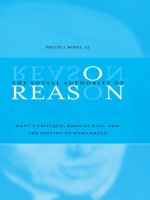HUMANKIND
Bạn đang xem bản rút gọn của tài liệu. Xem và tải ngay bản đầy đủ của tài liệu tại đây (931.68 KB, 12 trang )
HUMANKIND’S INVENTION WITH NATURE
After studying this chapter, you should be able to
1. Discuss how ancient people affected the environment.
2. Explain the progress made in the field of agriculture.
3. Identify the advances in the area of medicine.
4. Enumerate the new technologies brought about by advances in engineering.
5. Get a glimpse of the bad side of human beings impact on the environment.
6. Enumerate some bad effects of modern technologies.
3.1. BALANCE OF NATURE
Scientists estimated that the earth is already around three billion years old, and it will exists for
another three billion years. The life of the earth depends mainly on the sun. If the gravitational pull
of the sun remains constant, the earth will continue to revolve around the sun in its present speed.
There is a delicate balance between the centrifugal force of the earth as is goes around the sun.
If the sun continue to shine the way it is now, then the earth will continue to receive radiant energy
needed by the living creatures. Again, there is a delicate balance here. Too much sunshine will
make the earth too hot for most living beings to survive. In short, the balance of nature is so
delicate that any action that might upset such balance could have catastrophic results.
For millions of years, this balance of nature has been maintained. The animals that antedated
humans for thousands of year did not really disturb the environment. The effect they made on the
environment was minimal and Mother Nature easily recovered.
During the dawn of civilization, humans and the predators lived in very similar ways. Both hunted
for food and dwelt in natural habitats, like caves. With this kind of life, they did not alter the
environment. But, since humans were more intelligent and more cunning, plus the fact that they
walked erect and made use of their hands, they were able to invent weapons to help them. Axe
from stones and spears from sharp object made them better hunters than the animals. And when
they learned the use of fire, they cooked their food with it, warmed their bodies by it, and heated a
lot of things to help them survive. That was when humans proved their superiority over animals.
When they learned to eat green leafy vegetables and learned how to cultivate them, they started to
alter the environment. They made clearings in the forests and planted vegetables. When the land
was no longer that fertile, they abandoned the place and cleared other lands. That was the beginning
of forest destruction. Then they learned how to domesticate animals and lived in a permanent
dwelling which was made of the products of the environment, like wood for the structure and
leaves for roofing. They had to change the environment some more. Fortunately, there were not so
many people at that time, so the environment was able to recover. The balance of nature remained.
As the population increased and the needs of people became more complex, they put greater and
greater pressure on the environment. Larger houses were constructed from different materials,
strong fences to protect them from enemies, irrigation canals for agriculture, and large enclosures
for animals, all these required more change in the environment. But even then, there was no serious
damage to the environment from which nature was unable to recover. It could be said then that by
and large, humans lives for many, many years in harmony with the environment.
The rise in civilization of the Sumerians, the Babylonians, the Egyptians, the Greeks, and the
Romans placed additional burden on Mother Earth, especially in the terms of land used for public
buildings, monuments, and, of course, houses. With more lands used for agriculture and the upkeep
of animals, especially those used in war, changes in the environment became more permanent. But
even then, they were not causes for worry.
It was only during the rapid progress in knowledge about the world, followed by the so-called
industrial revolution, when humans made greater impact on the environment.
Guide questions
1. Explain in details the meaning of balance of nature
2. Name some ways by which humans upset the balance of nature.
3.2. PROGRESS IN AGRICULTURE, ENGINEERING, AND MEDICINE
Because of their superior intelligence, aided by the virtues of curiosity, imagination, and creativity,
humans were able to discover the many laws of nature, and they used this knowledge to control
parts of nature mostly for the benefit of humankind, in general.
In the field of agriculture, the knowledge of genetics produced larger and better varieties of fruits
and vegetables. These varieties gave better yields per area planted and were more resistant to
diseases. Some examples will be enumerated to highlight the point.
Better yielding varieties of rice, wheat, and potatoes have resulted in bumper harvest in many parts
of the world. As the direct consequence, the problem of feeding the growing populations was partly
solves by these discoveries.
Scientists were able to breed seedless grapes and seedless papayas. Mangoes are now harvested all
year round. And perhaps, the other fruits may soon be grown seedless, like melons, and
watermelons. Large varieties of guavas and Santo are now in abundance.
In the field of medicine, doctor and the scientists were able to discover the cure for many diseases,
thus prolonging and preserving producing healthier babies. The end result of all these are a much
faster rate of population increase.
In the field of animal science, researchers were able to improve the breed of animals used for food.
Faster- growing chickens and pigs and cultured fish are some good examples. Artificial hatching of
eggs was invented. All these resulted in more food for the fast-growing population of the world.
In the field of engineering, scientists invented better means of transportation on land, at sea, and in
the air. The more recent inventions include the bullet train that can run up to 500 kilometers (km)
per hour, airplanes that can carry up to 700 passengers, and large ships powered by nuclear fuel.
Landscapes have been altered to improve services to the people. For instance, dams were built to
produce electricity for homes and factories. Oil, coal, and other fossil fuels were mined to power
these new inventions.
For more comfort at home, scientists invented artificial lighting, air-conditioning systems,
refrigerator to preserve food better, radio and television for faster and better dissemination of
information and for entertainment, and all those electric gadgets in the kitchen to the delight of
many housewives.
In the field of food technology, we can choose from a very wide variety of food available in the
market, caned goods of all kinds, powered milk, packed lunches, preserved fruits and vegetables,
and many others.
All there may be considered as the good impact humans have made on the environment. As a result
of these inventions and new technology, people are living better food, live in more comfortable
homes, enjoy their vacations more, get better health services, travel faster, and dress better. In
short, they can do a lot better than their ancestors.
3.3. ADVERSE EFFECTS OF PEOPLE’S ACTIVITIES
Humankind’s intervention with nature has its adverse effects too. These include the pollution
produced by modern technology and its ill effects on the environment (disruption of the atmosphere
which causes greenhouse effect, ozone depletion and acid rain); among others; pollution of the
water system, deforestation, improper disposal of solid wastes, as well as nuclear wastes; and noise
pollution.
3.3.1. The greenhouse effect
Figure 3.1: The greenhouse effect
Too much carbon dioxide and other gases emitted by factories are accumulating in the atmosphere.
These gases allow sunlight to penetrate the earth’s atmosphere but unfortunately, they also trap
radiant heat and revert its escape into outer space.
The immediate consequence is global warming, which is better known as the green-house effect.
The rise in the average temperature of the earth could have serious consequences. Among them is
the melting of ice and glaciers in the North and South poles. This will raise the water level in many
areas of the world, resulting in the submersion of the low-lying coastal towns and cities.
3.3.2. Ozone depletion
High above the earth’s atmosphere, between 15 and 59 km above the earth, is a layer of ozone (O
3
).
It is formed when ultraviolet radiation (UV) splits a molecule of oxygen (O
2
), and the free oxygen
atoms (O) combine with other oxygen molecules. Ozone acts as a filter in the upper atmosphere,
preventing the harmful ultraviolet radiation of the sun from reaching the earth. Scientists
discovered that compounds of carbon such as carbon dioxide (CO
2
) and chloroflofuorocarbons
(CFCs), nitrogen oxides (NO) and methane break up ozone molecules, thereby gradually depleting
it.
Figure 3.2: Ozone depletion
In fact a large ozone hole was discovered above the tip of South America. The people directly
below it may experience skin irritations and soreness in their eyes. This may be due to the higher
intensity of harmful ultraviolet radiations hitting them.
Ozone levels, on the average, have declined by around 2 percent between 1969 and 1988. But in
some parts of the world, the decrease in much higher. For example, in Melbourne of Australia,
ozone levels dropped by as much as 10 percent in 1987, causing a 20 percent increase in ultraviolet
radiation reaching the ground.
3.3.3. Acid rain
Sulfur and nitrogen oxides are released from industrial factories, electrical power plants, smelting
plants, and motor vehicles.





